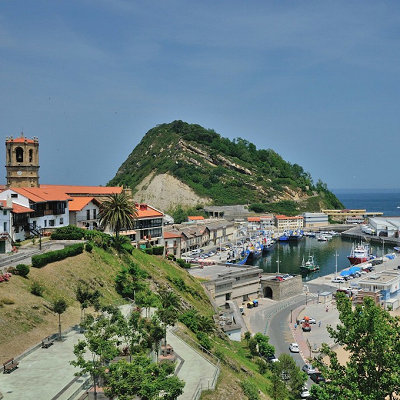
Like us on Facebook
PLACE NAMES




|
|
Getaria
|

|
|
Getaria is a coastal town located in the province of Gipuzkoa, in the autonomous community of Basque Country, in the North of Spain. This coastal village is located on the Urola Coast, with Zarautz to the east and Zumaia to the west.
Getaria is known for being Juan Sebastian Elcano's hometown, a seaman well-known for being the first man to circumnavigate the earth. He was captain of the Nao Victoria, the one ship in Magellan's ill-fated fleet which completed the voyage.
Today, Getaria is also famous for its restaurants serving grilled fish and a white wine with a protected designation of origin which is cultivated in the surroundings of this coastal town and takes the name of Getariako Txakolina. Moreover, the Cristobal Balenciaga Museum is also located in this village.
Thus, its most famous sons are Juan Sebastian Elcano, captain of the Nao Victoria, Admiral Miguel de Oquendo, who commanded the Guipuzcoa Squadron of the Spanish Armada, the explorer Domingo de Bonechea, and the couturier Cristobal Balenciaga Eizaguirre.
In May 2012, a two-man team from Getaria won Google's "Model Your Town" competition by creating a complete 3D representation of their hometown.
Traditionally, the town's name has been written as Guetaria. However, since 1980, the official toponym has become Getaria, which is the adaptation of the modern Basque orthography. Thus, in Spanish it is written Guetaria, and, though pronounced the same, in Basque it is written Getaria.
Apart from the Getaria of Gipuzkoa, there is another town 61 kilometers up the coast in Lapurdi (Labourd), the French Basque Country, which is called Guethary. The Basque pronunciation and spelling of the two towns is the same. Both villages are located on the Basque coast, and throughout history, many have sought the origin of the towns' names. Based on archaeological findings, the most convincing hypothesis is that the name of Getaria comes from the Latin word "cetaria". In the classic Latin, pronounced as [ketaria], it means a place were fish is canned. Indeed, in both places, evidence of Roman installations for canning fish have been found.
Another possible origin of the name is "guaita" in the Gascon language which means "lookout". During the Middle Ages various villages on the Basque coast were colonized by gascons, and among these villages both Getarias could be found. Therefore, it was believed that Getari could be the result of a mix between "guaita" and "-ari", a suffix that is used in the Basque language for professions and would mean vigilante. For others, though, the name of Getaria results from the mix of "guaita" and "-erri", meaning town, creating a word that means the town of the vigilant.
The municipality of Getaria occupies a section of the central coast of Gipuzkoa in the Cantabrian Sea. This section of the coast consists of a steep ledge on which a series of coves and points have formed through erosion.
The historic centre of Getaria is located just between the mainland and the mountain San Antón, also called the mouse of Getaria due to its mouse-like shape. This mountain that characterizes the town, was an island until the 16th century.
In the interior part of the township, the mountain Garate (278 m) is located. This mountain runs parallel to the coast, and in its smooth skirts lie several farms belonging to the township of Getaria. These farms are typical of the Basque Country and they are called baserri.
Nearly all the land situated between the mountain Garate and the coast is covered in vineyards due to the microclimate that this area generates.
 Feel free to Email me any additions or corrections Feel free to Email me any additions or corrections
LINKS AVAILABLE TO YOUR SITE
| | |





